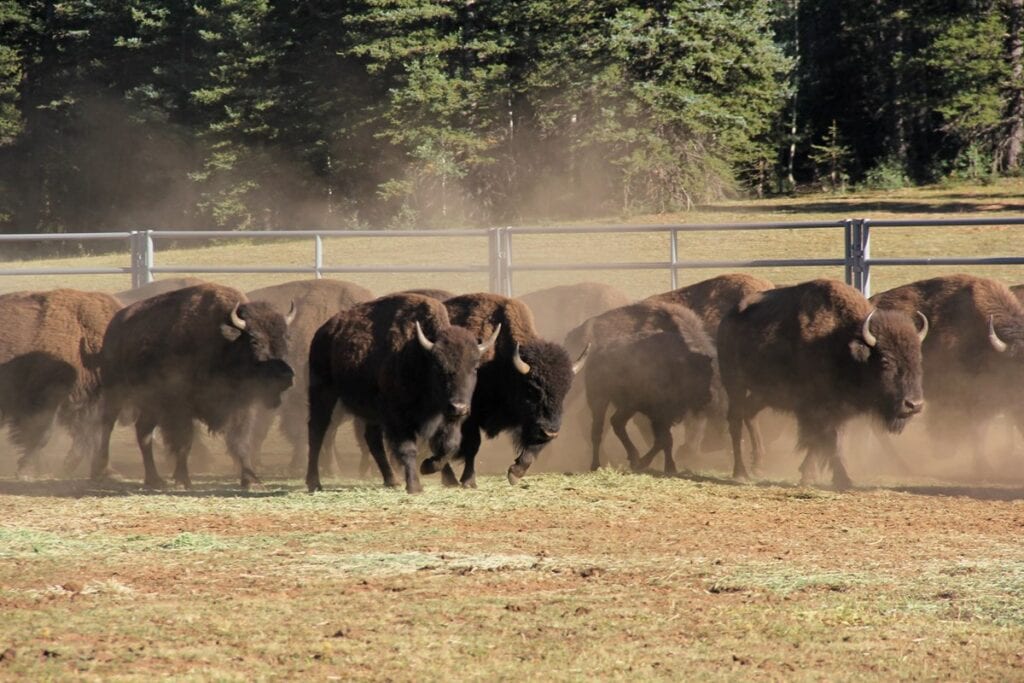Bison herd to be reduced to 200

Bison gallop in front of corralling fence on the North Rim of Grand Canyon. Photo courtesy of National Park Service
GRAND CANYON, AZ—According to the National Park Service (NPS) the herd of 600 bison on the Grand Canyon North Rim will be reduced to 200 by a “lethal removal program.” The program gets underway in September 2021.
An April 2014 NPS press release detailed the history of how the bison herd got to the North Rim: “A herd of bison was brought to the Grand Canyon region in the early 1900s and has been managed since 1950 by the Arizona Game and Fish Department in the House Rock Wildlife Area (HRWA) on the Kaibab National Forest through an interagency agreement with the United States Forest Service.
During the late 1990s, the bison began ‘pioneering’ up to the top of the Kaibab Plateau and into Grand Canyon National Park (GCNP). A combination of public hunt pressure, drought and fire, and reduced forage quality in House Rock Valley during the 1990s may have contributed to the bison moving through Saddle Mountain Wilderness and onto the higher elevations of the Kaibab Plateau. Over the past several years, very few bison have returned to HRWA and most now spend a majority of their time inside the park, with many not leaving GCNP.”
The press release laid the foundations for a long period of public input on how to deal with the escalating negative impact the bison were having on the North Rim environment, but nowhere did it mention hunting, either in a controlled program, or for recreation. The first efforts at herd reduction were two major relocation programs. According to a September 2019 NPS press release, 31 bison were transferred to Oklahoma to join the herd of the Quapaw tribe. Nowhere in this press release is a bison hunt mentioned. This transfer was made possible through a cooperative effort with the 15-year-old Intertribal Buffalo Council (ITBC). According to their website: “The Intertribal Buffalo Council is a collection of 69 federally recognized Tribes from 19 different states whose mission is to restore buffalo to Indian Country in order to preserve our historical, cultural, traditional, and spiritual relationship for future generations. To reestablish healthy buffalo populations on Tribal lands is to reestablish hope for Indian people. By returning the buffalo to Tribal lands will help heal the land, the animal, and the spirit of the Indian people.”
One of the accomplishments of the ITBC was to prompt Congressman Don Young (R-AK) and cosponsors Congresswoman Deb Haaland (D-NM) and Congressman Tom Cole (R-OK) to introduce a bill in November, 2019, the Indian Buffalo Management Act. Although the bill is not dead, it still sits on the Union Calendar, a separate calendar in the House that schedules bills involving money issues. This highlights one of the deeper issues impacting Indian Country, the difference between introducing a bill, and getting it enacted as law. People can help by contacting their local Congressperson or Senator and express their support for the Indian Buffalo Management Act.
In September, 2020, in another cooperative effort with ITBC, 57 bison were successfully transferred from the North Rim to four Great Plains tribes. Again, the NPS press release does not mention a hunt, just that “operational details of future herd reduction are still being discussed.”
However, back in 2017, the NPS issued a Finding of No significant Impact (FONSI) in the North Rim bison herd reduction plan, greenlighting a prospective hunt, or in the language used at the NPS website: “using lethal removal with skilled volunteers.” The question remains unasked, and so unanswered, is during all the decades that Arizona Game & Fish was responsible for herd management were sensible proactive steps not taken when herd management was small and within budget constraints, therefore not necessitating lethal reduction measures? Did the NPS always know the FONSI option was what the hunting public preferred and had the power to make reality?
According to NPS, the difference between a straight up bison hunt and a lethal removal program is “during lethal removal the animals are destroyed primarily for management purposes; in hunting the animal is destroyed for recreational purposes.”
But when it comes to stalking and shooting bison, there is no operational difference between herd management and recreational hunting. Perhaps the NPS and the hunting public see it as a win-win: the herd is environmentally secured, while hunters get to participate in a sport that historically, and tragically, reduced the bison herds of this nation from untold millions to a few thousand head.
(Contact James Giago Davies at skindiesel@msn.com)
The post Bison herd to be reduced to 200 first appeared on Native Sun News Today.
